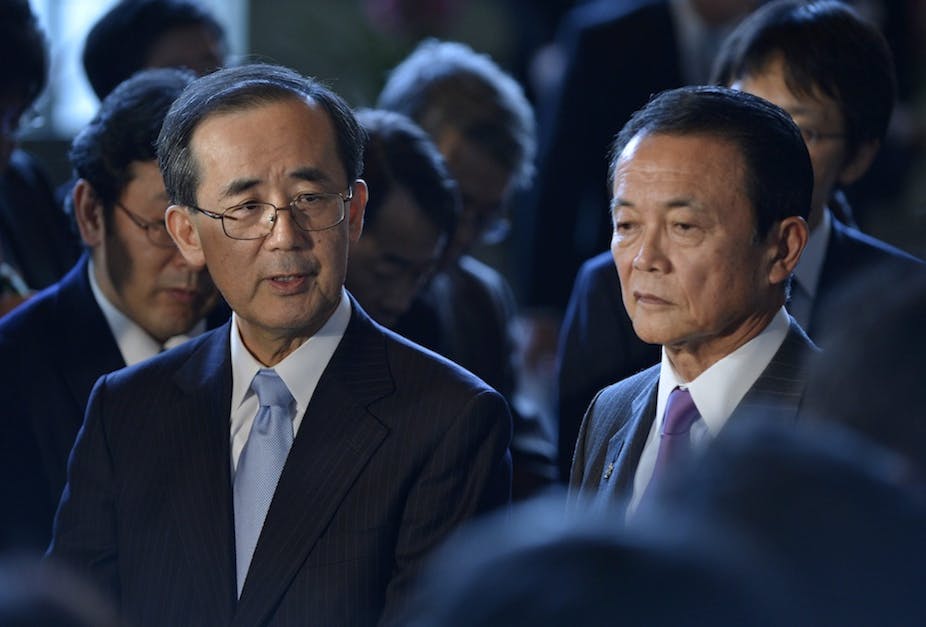The coordinated policies of the Bank of Japan and the Japanese government in increasing money supply has had some interesting short-term implications for the Australian dollar.
Since the Bank of Japan announced on December 22 it would adopt more expansive monetary policy, the Australian dollar has jumped 7%. It is currently at its highest level in two years with a rate of 94.2011 Yen per Australian dollar.
But this rally is likely to be a short-term effect. Policies that weaken the yen have already been subject to international criticism, with warnings of “currency wars”. (Japan has denied the policies are intentionally designed to weaken the yen.)
This week, the BoJ and the Government announced a policy package including target inflation of 2% and the ongoing purchasing of long-term treasury-bonds (2 trillion yen) and short-term treasury-bonds (10 trillion yen) starting from early 2014.
This follows on from the BoJ’s decision in late December to take an expansionary policy consistent with the election promise made by the new government led by Prime Minister Shinzo Abe. According to this plan, reserves for the expansionary monetary policy will rise by 11%: from 91 trillion to 101 trillion yen (US$115 billion).
As a result, the BoJ can purchase more short-term and long-term government bonds by 5 trillion yen respectively. In addition, BoJ will supply loan funds to stimulate commercial bank’s lending to private sector. BoJ also did not change the current overnight call rate.
This expansionary position is a departure from the BoJ’s position of keeping money supply tight even when government has adopted large negative saving policies and has created a “fresh” shock to the market.
The previous discrepancy between fiscal and monetary policy has caused the counter-intuitive exchange rate movements of the yen in the past. When the Japanese economy was in deep recession in 1994, the yen appreciated more than 60% against US dollar from the 1990 level. In contrast, the recent policy packages are well coordinated between the BoJ and the government, thus allowing the yen to move more predictably than before.
The Australian dollar’s rally against the yen seems to be a trend, at least while the new Liberal Democratic Party (LDP) government enjoys a political honeymoon with the media and the public in Japan.
However, there are limitations to it being evaluated as a signalling effect. With the BoJ putting off additional bonds purchasing until 2014, investors in the Japanese share market responded by pushing the Nikkei down 0.4% at close.
The effectiveness of monetary policy vis-à-vis fiscal policy as a countermeasure to recession is usually indirect and thus uncertain. The initial announcement was made just after Mr Abe publicly indicated the possibility of “printing” money, implying that this expansionary monetary policy reflects heavily on politicians’ wishes to depreciate or maintain the trend of weakening yen currency in the context of regional politics. Korea’s new president Keun-He Park decided to send her first presidential envoy to China ahead of US and Japan.
Japan’s diplomatic relationship with China has worsened due largely to the dispute about the Senkaku Islands. This explains why Abe decided to travel to south-east Asia for his first overseas mission as the new prime minister.
Economic policies influenced by politicians during election periods often have limited effectiveness. Domestically, the rising debt liability to the government due to the expansionary open market operation (i.e., holding more bonds) will create a huge burden to the existing national debt which is already a dazzling 237% of GDP. This snow-balling of national debt without a convincing fiscal policy reform is a potential bomb for the LDP Government.
The public’s anger will rise as inflation weakens householder’s purchasing power. Rational Japanese may save even more to pay their pension later along with the government negative saving measures. Then, the path of the “multiplier effects” will be shortened.
Internationally, sustained yen depreciation is likely to face a challenge from other countries. Yen depreciation will erode price competitiveness of US and Korean products in global export markets. The Japanese export-led growth in the 1970s and 1980s is unlikely to repeat, although US may allow yen depreciation.
The yen-carried capital inflow in Asia, including Australia and Korea, tend to be vulnerable to external shocks and often cause unnecessary uncertainty in these countries. It caused the roller-coaster type of exchange rate movements in Korea and Australia as witnessed during the 1997 Asian crisis and the GFC. After falling below US50c in the early 2000s, the Australian dollar surged to US98c by July 2008 but plummeted back to US64c in March 2009.
So while the Australian dollar is likely to remain strong throughout the year, the sustainability of this appreciation will be due largely to the resource-boom-led economic growth and high Australian interest rates.
Japanese expansionary policy has accelerated the strengthening of the dollar, but this effect is likely to be a temporary shock, due to Japan’s domestic and international political constraints.
Cleaning up the bad loans in a weak banking system and financial bankruptcies left from “the lost decade” of the 1990s remains a challenge.
Fiscal policy reform to reduce national debt has been a major political slogan since that period. Unless there is a credible tool for this reform, Japanese growth will be delayed as Japanese consumers will continually suspect their policymakers’ real intention is to delay the announced fiscal policy reform and private investment will be delayed.

